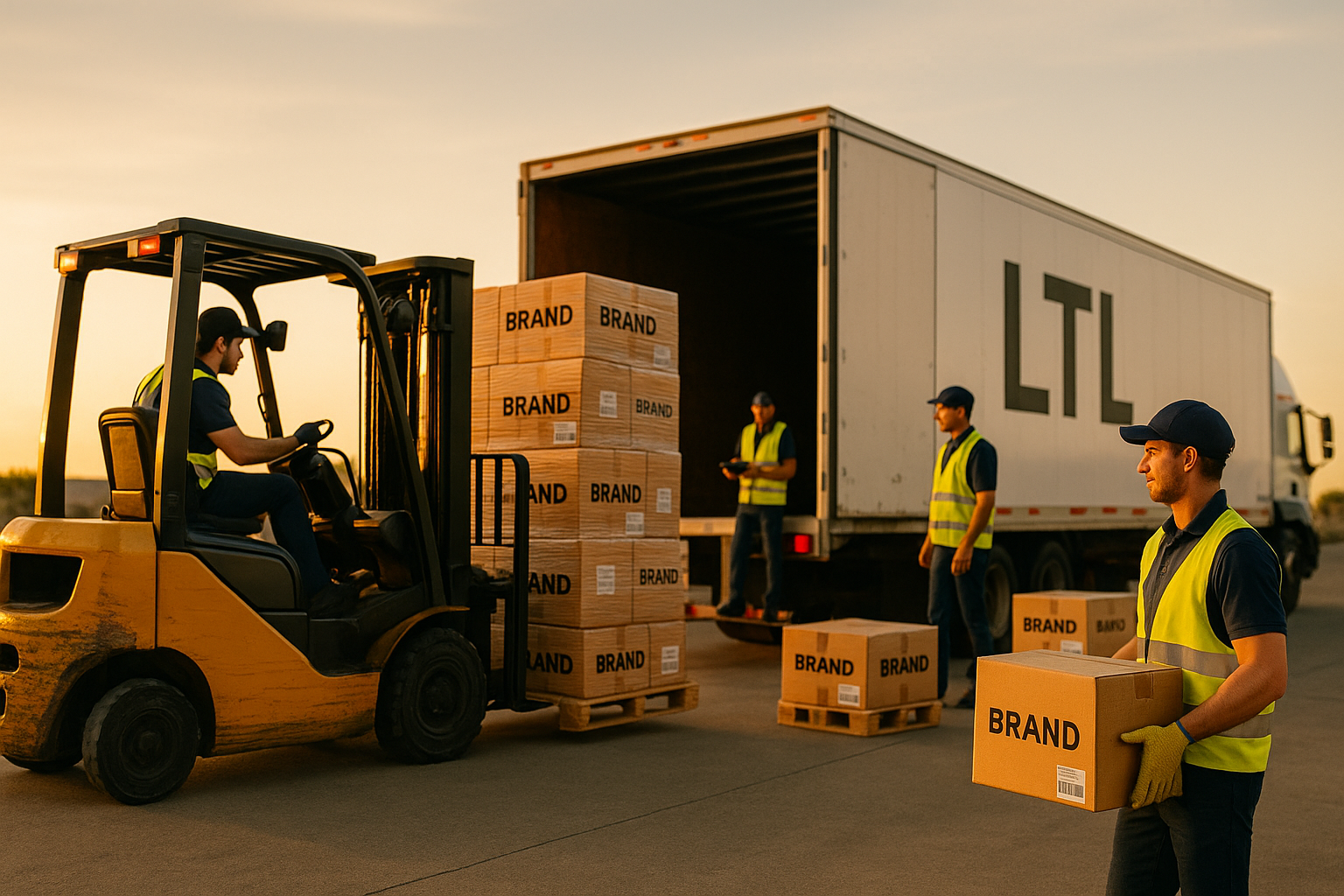Freight consolidation is a process that involves combining multiple smaller shipments into a single larger one, which allows businesses to take advantage of economies of scale, reduce shipping costs, and optimise their supply chain.
In today's competitive business environment, freight consolidation offers a strategic solution to streamline logistics and maximise savings, which ultimately improves a company's bottom line.
In this article, we will explore how freight consolidation works, its benefits, and how businesses can effectively use it to save money. We will also look into different strategies, the role of freight forwarders, and practical examples of how businesses have reduced shipping costs through this method.

Let's Get Straight To The Point
Freight consolidation involves combining multiple smaller shipments into one larger shipment, allowing businesses to save money on transportation by leveraging economies of scale. Key benefits include cost savings, better negotiated rates, improved supply chain efficiency, reduced carbon footprint, and better inventory management.
Freight forwarders play a crucial role by negotiating rates, handling documentation, and offering customised solutions. However, businesses need to consider factors like timing, shipment compatibility, and additional costs before consolidating freight.
Popular types of consolidation include Less Than Truckload (LTL), Full Container Load (FCL), and air freight consolidation. By consolidating shipments, businesses can significantly reduce shipping costs, improve logistics, and enhance overall efficiency.

How Freight Forwarders Help in Freight Consolidation
1. Expertise and Experience
Freight forwarders are experts in logistics and shipping, and they play a crucial role in the freight consolidation process. These professionals have the knowledge and experience to efficiently manage the consolidation of shipments, ensuring that goods are properly grouped, packaged, and shipped in the most cost-effective manner.
2. Negotiating Better Rates
Freight forwarders work with multiple carriers and shipping companies, which gives them the leverage to negotiate better rates for their clients. By consolidating shipments, freight forwarders can leverage their relationships with carriers to secure lower shipping rates, which are then passed on to their customers.
3. Managing Documentation
Freight forwarders handle all of the necessary shipping documentation, including bills of lading, customs declarations, and import/export permits. This ensures that businesses remain compliant with regulations and avoid costly delays or penalties.
4. Offering Customized Solutions
Freight forwarders can offer customised solutions based on the unique needs of a business. Whether a company needs help consolidating shipments for international delivery or optimising its supply chain management, freight forwarders provide tailored services that meet specific requirements.
Key Considerations When Using Freight Consolidation
While freight consolidation offers numerous benefits, it is essential for businesses to carefully consider several factors before implementing this strategy. Below are some of the key considerations to keep in mind:
1. Timing
Freight consolidation often involves longer lead times compared to direct shipments, as the process of collecting and consolidating freight can take time. Businesses need to plan ahead and ensure that the timing of their shipments aligns with their inventory needs and customer demands.
2. Destination and Delivery Schedules
Consolidating freight may result in delays if the shipments are bound for multiple destinations. It is important to work with a freight forwarder who can efficiently manage the distribution of goods to ensure that all shipments are delivered on time and to the correct locations.
3. Handling and Packaging Requirements
Some goods may require special handling or packaging due to their size, fragility, or nature. Businesses need to consider whether consolidated shipments will meet these requirements and ensure that their goods are properly protected during transit.
4. Compatibility of Shipments
Not all shipments are suitable for consolidation. Businesses must evaluate whether their goods are compatible with other shipments in terms of size, weight, and nature. For instance, hazardous materials or temperature-sensitive products may not be suitable for consolidation with other types of freight.
5. Cost of Consolidation
Although freight consolidation can lead to cost savings, it is essential to account for the additional costs associated with the process. These costs may include the fees charged by freight forwarders or 3PL providers for handling and consolidating the freight, as well as any additional charges for packaging, storage, or delivery.
What is Freight Consolidation?
Freight consolidation refers to the practice of combining multiple smaller shipments from different suppliers or manufacturers into a single larger shipment. The primary goal is to reduce the cost per unit of shipping by sharing the expenses across several shipments. This practice is especially beneficial for small and medium-sized businesses that do not have the volume or frequency to fill entire containers or trucks on their own.
By pooling shipments, businesses can save on shipping costs and improve overall efficiency. Freight consolidation can be applied to air freight, ocean freight, and ground transportation, depending on the nature of the business and the volume of goods being shipped.
How Freight Consolidation Works
Freight consolidation typically involves a freight forwarder or third-party logistics (3PL) provider. These professionals are responsible for gathering shipments from multiple clients, grouping them based on destination, and then arranging for transportation. Once consolidated, the shipment is sent as a single, larger load, which allows the businesses involved to take advantage of volume discounts and lower shipping rates.
The process of freight consolidation includes the following:
Gathering Shipments: Freight from various suppliers or customers is collected by a freight forwarder or 3PL.
Consolidating the Freight: Shipments are grouped together by destination, cargo type, or weight to maximise efficiency.
Shipping the Consolidated Load: The consolidated freight is shipped as a single larger load, which typically enjoys reduced rates for shipping.
Unloading and Delivery: Upon arrival, the consolidated shipment is broken down and delivered to the final destinations.
The Benefits of Freight Consolidation for Your Business
Freight consolidation offers several advantages for businesses looking to optimise their shipping processes and reduce costs. Below are the key benefits:

1. Cost Savings
The most obvious and significant benefit of freight consolidation is the potential for cost savings. By combining multiple smaller shipments into one, businesses can reduce the overall cost of transportation. This is particularly advantageous for companies that regularly ship small volumes of goods, as they would otherwise be subject to higher shipping rates for low-volume shipments.
2. Better Negotiated Rates
When companies consolidate their freight, they often gain access to better shipping rates. Freight forwarders and 3PL providers typically have established relationships with carriers, and they can negotiate lower rates on behalf of their clients. This can lead to discounted rates that individual businesses would not be able to secure on their own.
3. Improved Supply Chain Efficiency
Freight consolidation streamlines the shipping process, leading to better supply chain efficiency. Combining shipments reduces the need for multiple pickups, drop-offs, and handling, which saves time and reduces the risk of delays. As a result, businesses can improve their on-time delivery performance and ensure that products reach their customers in a timely manner.
4. Reduced Carbon Footprint
By consolidating freight into fewer shipments, businesses can contribute to a reduction in carbon emissions. Fewer shipments mean fewer trucks, planes, and ships are needed to transport the goods, which ultimately reduces the environmental impact. For companies looking to improve their sustainability efforts, freight consolidation provides an effective way to reduce their carbon footprint while still maintaining efficient operations.
5. Improved Inventory Management
Freight consolidation can also help improve inventory management by ensuring that goods are delivered on time and in the right quantities. When shipments are consolidated, businesses have a clearer picture of when their products will arrive, making it easier to plan for inventory replenishment and reduce the risk of stockouts or overstocking.
Types of Freight Consolidation
1. Less Than Truckload (LTL) Freight
One of the most common forms of freight consolidation is Less Than Truckload (LTL) shipping. LTL freight involves combining smaller shipments from different businesses into a single truckload. This method is ideal for companies that do not have enough cargo to fill an entire truck but still want to share the transportation costs with other businesses. LTL shipping is widely used for ground transportation and is available for both domestic and international shipments.
2. Full Container Load (FCL) Freight
For ocean freight, Full Container Load (FCL) consolidation involves grouping smaller shipments from different businesses into a single container. This method is typically used for larger shipments that require a full container but do not have enough volume to fill an entire container. FCL consolidation can help businesses save on the costs of ocean freight by sharing container space with other shipments.
3. Air Freight Consolidation
Air freight consolidation involves combining smaller shipments from different businesses into a single larger shipment for air transport. This method is particularly useful for businesses that need to ship products quickly but do not have enough volume to justify the cost of a dedicated flight. Air freight consolidation allows businesses to take advantage of discounted rates while still meeting their timely shipping needs.
4. Cross-Docking
Cross-docking is another form of consolidation where goods are delivered to a central warehouse or distribution centre, unloaded, and then immediately reloaded onto outbound trucks for delivery to their final destinations. This method eliminates the need for storage and helps businesses streamline their supply chain by reducing handling and transit time.

Real-World Examples of How Freight Consolidation Saves Money
1. Small Business Example
A small online retailer that sells clothing to international customers found that they were spending significant amounts on shipping costs for each individual order. By working with a freight forwarder to consolidate their shipments, the retailer was able to combine several smaller orders into a single container shipment, drastically reducing their overall shipping costs.
2. Manufacturing Business Example
A manufacturing company that imports raw materials from different suppliers across the globe used to pay high costs for international shipping. By consolidating the shipments into one large container, the company was able to reduce shipping fees and improve its inventory management, saving both time and money.
Conclusion
Freight consolidation is a powerful tool that businesses can use to optimise their supply chain and reduce shipping costs. By combining smaller shipments into larger ones, businesses can take advantage of economies of scale, negotiate better shipping rates, and improve their overall logistics efficiency. However, it is important to carefully consider factors such as timing, destination, and compatibility of shipments before implementing this strategy. By working with experienced freight forwarders, businesses can ensure that their shipments are properly consolidated, delivered on time, and within budget, ultimately improving their bottom line.
FAQs
Is Freight Consolidation Suitable For Small Businesses?
Yes, freight consolidation is particularly beneficial for small businesses that don't ship large volumes. It allows them to pool their shipments with others, reducing the cost per unit and making shipping more affordable, even for smaller quantities of goods.
Can Freight Consolidation Work For International Shipments?
Yes, freight consolidation is often used for international shipments. Whether by air, sea, or land, businesses can combine their goods with other shipments to reduce the high costs of international shipping. Freight forwarders play a key role in managing the logistics and ensuring compliance with international shipping regulations.
How Does Freight Consolidation Reduce A Company’s Carbon Footprint?
By consolidating shipments, fewer vehicles (trucks, ships, planes) are needed to transport goods, resulting in lower carbon emissions. Fewer trips lead to less fuel consumption and reduced environmental impact, making consolidation a more sustainable shipping option.
Is It Always Cheaper To Consolidate Freight?
Freight consolidation can save money in many cases, but it’s not always the most cost-effective solution for every type of shipment. Businesses need to evaluate factors such as shipment volume, destination, handling requirements, and lead times to determine if consolidation is the most affordable option.
How Do I Get Started With Freight Consolidation?
To get started, businesses should contact a freight forwarder or third-party logistics (3PL) provider who specialises in freight consolidation. They will guide you through the process, help consolidate shipments, and negotiate favourable shipping rates. It's important to assess your shipping needs and determine if consolidation is right for your business.

